Extensive Donor Site Keloids in Follicular Unit Extraction Hair Transplantation
January 2017
in “
International Journal of Trichology
”

TLDR Hair transplant can cause hard-to-treat keloids in some patients.
The document discusses a case of extensive keloid formation at the donor site following a follicular unit extraction (FUE) hair transplant procedure. The patient, a 30-year-old male, experienced growth of reddish raised itchy areas over the occiput 8 months after the procedure. The keloids were diagnosed as FUE-induced and were found to be resistant to treatment with triamcinolone acetonide intralesional injections. The document suggests that hair transplant surgeons should be aware of this potential complication, especially in patients with previous keloidal tendencies. It also discusses preventive strategies for this difficult to treat complication, including immediate postoperative prophylactic measures such as pressure therapy, silicone gel sheeting, silicone gel, and flavonoids. Early intervention in potentially developing lesions with intralesional steroids, 5-flurouracil, interferons, and cryotherapy is recommended.


